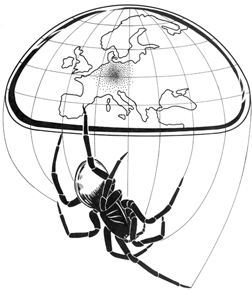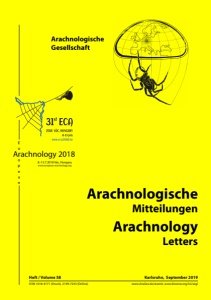Arachnology Letters - Instructions to authors
Instructions for authors of Arachnologische Mitteilungen (subtitled Arachnology Letters) - New (12/2024)
General information
Schriftleitung/Editorship Arachnologische Gesellschaft e. V. – www.arages.de
Contact: editors(at)arages.de (English manuscripts), schriftleitung(at)arages.de (German manuscripts); Tobias Bauer, Karlsruhe (DE), E-mail: tobias.bauer@smnk.de; Dr. Petr Dolejš, Praha (CZ), E-mail: petr.dolejs(at)nm.cz; Dr. Anna Šestáková, Trnava (SK), E-mail: asestakova(at)gmail.com; Dr. Konrad Wiśniewski, Słupsk (PL), E-mail: konrad.wisniewski.araneae(at)gmail.com
The Open Access journal Arachnologische Mitteilungen, subtitled Arachnology Letters, publishes scientific papers about West Palaearctic (in a broader sense) arachnids (excluding papers solely on mites and ticks) in German or (British) English. The main focus lies on the topics of taxonomy, faunistics, biogeography, morphology, ecology, palaeontology and genetics. Data papers are also welcome.
Manuscripts should be submitted to one of the e-mails (editors(at)arages.de or schriftleitung(at)arages.de) as a digital version. Manuscripts will be sent to at least two reviewers (Peer Review). Authors are welcome to propose potential reviewers.
The author/s themselves are wholly responsible for the contents of the article. The publisher accepts no responsibility for the correctness, accuracy or completeness of the article, or for considering the rights of third parties. The editors reserve the right to make changes as they see fit.
Separata will be made available to the authors in a digital form (PDF, preferably sent by e-mail). PDFs are available for download on the AraGes-website and BioOne-website (Open Access) and authors may also make them available on other sites.
Manuscript preparation
Structure: Following a concise Title, the next line is the author(s) full name(s), the last author added with &. The address/es of the author/s contains the full name(s) (surname in capitals) and address(es) of the author(s), including the E-mail-address(es). Authors are invited to submit their ORCID IDs. After this comes an Abstract briefly summarising the main results.
English manuscripts will receive a German abstract (Zusammenfassung), which begins with the German translation of the title (as well as in German manuscripts the English abstract begins with the English translation of the title). The editors can translate the abstract for non-German speaking authors. Title and abstracts in other languages can be provided, if related to the geographic area of the manuscript.
Next come a few precise Keywords, sorted alphabetically, which supplement the title (no repetitions from the title) for the purposes of bibliographic databasing. For the header line a short title has to be added. The arrangement of the text is preferably as follows:
Introductional chapter without a title,
Material and methods (or Study area, Methods, etc.),
Results,
Discussion,
Acknowledgements, including possible funding sources or award numbers to be used by BioOne,
References.
Formatting: The manuscript should be submitted as a Word document, if possible as a *.doc. It should only be written in "standard format" (the font does not matter here) and cleaned up (also applies to tables). No soft breaks, indents, tabs or anything else. Numbers/lists (regardless of whether numbers, letters, dashes or symbols) should be given at the beginning above the heading, as they are lost when read into the layout program and are therefore difficult to recognize (e.g. 3 contains numbering/lists). Bold, italic and capital letters only. Title, main text, all headings, legends, etc. should be left-justified without indents. The title, authors and main headings in bold, in normal text. The 3rd degree heading: bold with full stop, then continue with the paragraph on the same line. Blank lines between paragraphs are used only to separate major topics. All personal names, including authors of references and species, in normal text.
Formalities: The complete nomenclature of the species (author/s, first year of description) must be used when mentioning it in the abstract, for the first time in the text or in a complete species list, but not in the title. Generic and species names must be italicised (and regularly only these are in italics, exceptionally some abbreviations)! Country names in material lists in capital letters. Geographical coordinates (in the Geodetic System WGS 84) in decimal grades (with 3–5 decimal places) as well as altitude should be given for each locality. When describing a new taxon, the ZooBank number must be included. Especially in case of faunistic and taxonomic works, the accurate information on the habitat type, sampling method and time is appreciated. Do not use symbols to separate numbers in the thousands; decimal places are separated by a full stop. Dates should be in format 3.–7. Aug. 2017, number of specimens as 1 ♂, 3 ♀♀, 2 jj.
For tables it is very important that they are easily readable. Tables can be embedded in the WORD document or as separate EXCEL files. If they are larger than 178 mm, they should be marked as an appendix. Please mark in the text, where the tables and figures should be placed.
Figures and plates should be numbered consecutively in the sequence they are cited in the text, their arrangement must be obvious in the legends. Use only lower-case letters for numbering in images and text (Fig. 1a-d). Illustrations 1× as original and unedited as possible and the same illustration with scale and labeling. Images should have a width of at least 1016 pixels (1 column, 86 mm), 2102 pixels (2 columns, 178 mm) and 1594 pixels (11/2 columns, 135 mm). Prearanged panels are only used as a sample, also provide individual images here.
Graphics: It is important to note that EXCEL-graphs should be sent together with their xls-/xlsx-files, as the original data-table is needed for formatting. All photos, drawings, etc. have to be submitted also separately (lower quality versions can be in the document, this is helpful for the review process). Photographs should be submitted in colour (RGB, 4-5 Megapixel), so that they can be embedded as coloured images in the digital reprints. Coloured elements should remain readable and discriminable in monochrome. All drawings, both half-tones and line drawings, should be submitted as 8bit half-tone images (each 4-5 Megapixels, TIFF- or PSD-file format). Colour photos can be submitted as JPG-files (e.g. originals from the digital camera). They will be arranged according to their legends along with all other figures submitted with the manuscript. Alternatively, the author(s) can submit ready-formatted digital figures. However, in such cases authors should consult the editors with respect to file formats, etc. It should be possible to format the inscription of the single figures separately, e.g. as a layer in photoshop. Software and web sources and their licence used for map creations etc. must be properly cited.
Legends should be arranged in normal text above the tables (Tab. 1: …) and beneath the figures (e.g. Fig. 1: Species. a. opisthosoma; b-c. epigyne). Footnotes cannot be accepted.
Reference citations: In the text, if there are three or more authors, only the first author is cited (Schulze et al. 1969), several citations are separated by commas (Koponen 2000, 2008, Huber 2010a, 2010b – in alphabetical or in chronological order). Authors’ names should not be in small caps or capitals. The References list is arranged alphabetically by author and then chronologically. Do not write the title of a paper or a journal entirely in capital letters, even if this should be the case in the original. The basis for capitalisation in English article titles is English spelling (i.e. no capitalisation of nouns etc.). Journal names are not abbreviated. Papers with the same author(s) and years are identified by a, b, c etc. This can also be necessary for papers with three or more authors, by the same first author in one year. Journal name of Arachnologische Mitteilungen should be cited with the German title without the English subtitle. Doi-links should be added where possible (see below).
Examples:
Broen B von 1993 Nachweise selten gefundener oder gefährdeter Spinnen (Araneae) in der Mark Brandenburg. – Arachnologische Mitteilungen 6: 12-25 – doi: 10.5431/aramit0603
Chatzaki M 2008 A critical review of the spider family Gnaphosidae in Greece. In: Makarov SE & Dimitrijevic RN (eds) Advances in arachnology and developmental biology. Pensoft, Sofia. pp. 355-374
Holec M 2008 Písčiny u Oleška. Výsledky průzkumu pavouků [Písčiny u Oleška. Results of research of spiders]. Unpublished report to the Regional office in Ústí nad Labem. 20 pp. [in Czech]
Kovblyuk MM & Marusik YM 2012 First description of the female of the theridiid spider Robertus golovatchi (Araneae: Theridiidae). – Arachnologische Mitteilungen 44: 17-19 – doi: 10.5431/aramit4405
Lindgren L 2000 Island pastures. Metsähallitus and Edita, Helsinki. 203 pp.
Merkens S 2000 Die Spinnenzönosen der Sandtrockenrasen im norddeutschen Tiefland im West-Ost-Transekt – Gemeinschaftsstruktur, Habitatbindung, Biogeographie. Dissertation, Universität Osnabrück. 165 pp.
Nentwig W, Blick T, Bosmans R, Hänggi A, Kropf C & Stäubli A 2024 araneae – Spiders of Europe. Version 12.2024. – Internet: araneae.nmbe.ch (1. Dec. 2024) – doi: 10.24436/1
Opatova V & Arnedo M 2014 Spiders on a hot volcanic roof: colonisation pathways and phylogeography of the Canary Islands endemic trap-door spider Titanidiops canariensis (Araneae, Idiopidae). – PLoS ONE 9 (e115078): 1-31 – doi: 10.1371/journal.pone.0115078
Svatoň J & Majkus Z 1988 Príspevok k poznaniu pavúkov (Araneae) Plešivskej planiny [Contribution to the spider fauna (Araneida) in Plešivská planina plain]. – Ochrana prírody – Výskumné práce z ochrany prírody 6B: 203-242 [in Slovak, with English and German summaries]
World Spider Catalog 2024 World spider catalog. Version 25.5. Natural History Museum, Bern. – Internet: wsc.nmbe.ch (1. Dec. 2024) – doi: 10.24436/2
For automatic formatting of the references with a reference managing program like Endnote or Mendeley we provide two style files:
for Reference Manager and Endnote: AraMit2015.os
for Mendeley and other programs: arachnologische-mitteilungen.csl.
You can also retrieve this style via http://www.zotero.org/styles/arachnologische-mitteilungen.
The instructions to authors are downloadable as a PDF file (December 2024).
Ethical statement
Authors must ensure that they have written a completely original study, and if they have used other people’s books or statements, they must be properly cited. Authors should cite the publications that influenced the study in question. An author should not submit manuscripts representing the same study to more than one journal (or book) or if the study was already published in another journal (or book). Authors are fully responsible for meeting all respective country-specific or regional regulations concerning the sampling of organisms. In adopted figures, authors must always indicate the link and license to it. Funding for research projects that made the study possible must be indicated.
For manuscripts dealing with zoological nomenclature, we recommend that the authors, reviewers and editors follow the Code of Ethics in Appendix A of the International Commission on Zoological Nomenclature (https://code.iczn.org).
The editor is considering the legal obligations regarding defamation, copyrights and plagiarism. The editor can share the decision with other members of the Editorial Board or with reviewers. The editors are allowed to make corrections and changes of the text during the typesetting process. The editorial board is always willing to publish corrections, clarifications, retractions and apologies when needed.
Reviewers should not accept reviewing manuscripts 1) if s/he does not have the appropriate subject expertise and enough time to complete the review or 2) where this may result in a conflict of interest arising from competitive, collaborative or other relationships with the authors. The reviewer’s comments must be professional, focused on the work and not on the individuals. The reviewer must identify appropriate publications not cited by the author. Any such indication must be accompanied by an appropriate comment. The reviewer should draw the editor’s attention to any similarity, any overlap between the manuscript and previously published data.



